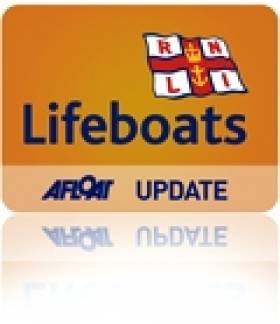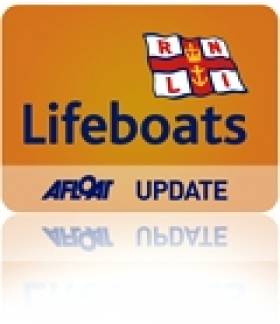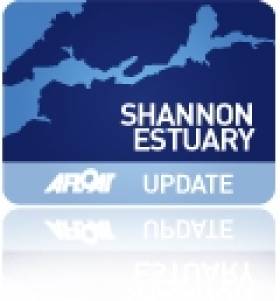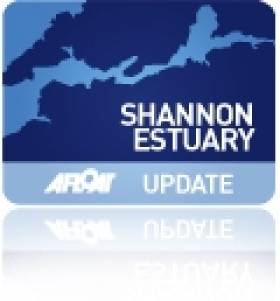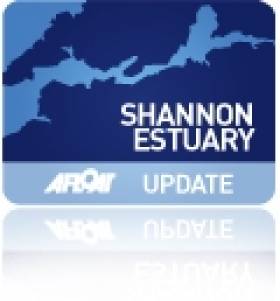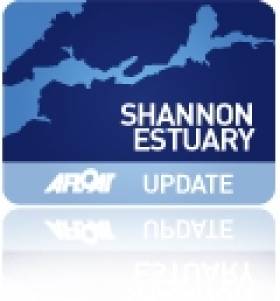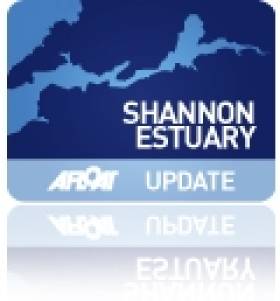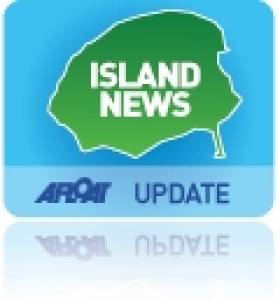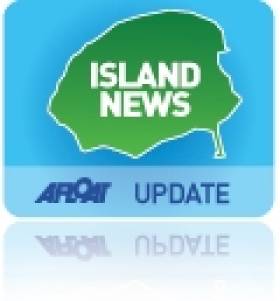Displaying items by tag: Shannon Estuary
Kilrush RNLI Lifeboat on Standby Following Aircraft 'Pan-Pan' Radio Call
#lifeboat – Kilrush RNLI on the Shannon Estuary was put on standby yesterday following a Pan-Pan urgency on board a small aircraft while on approach to Shannon airport.
An alert was received from Valentia Coast Guard yesterday afternoon at 3.06pm (Sunday 1 February) following a report that a small aircraft with six people on board had issued a Pan-Pan radio call as it approached Shannon Airport. It is understood the plane was experiencing fuel difficulties.
The volunteer crew assembled within minutes and prepared their inshore lifeboat for standby.
At 3.46pm, the plane made a safe landing at Shannon Airport. The Coast Guard requested the lifeboat and the crew to stand down.
Commenting on the call out, Pauline Dunleavy, Kilrush RNLI Lifeboat Operations Manager said: 'I would like to commend our crew for their quick response this afternoon in getting to the station and preparing the lifeboat for launch. Thankfully the aircraft was able to make a safe landing today.'
Plane 'Cargo Hold Fire Alert' Leads to Kilrush Lifeboat Call Out
#rnli – An early morning airline alert for Kilrush RNLI lifeboat gave its new Lifeboat Operations Manager her first callout in charge.
Newly appointed Lifeboat Operations Manager (LOM) at Kilrush RNLI, Pauline Dunleavy, had her first callout in charge of the Clare lifeboat station on the Shannon Estuary, when an alert was received early this morning (14 December 2014) and the lifeboat was launched to reports that a plane flying overhead had observed an indication that a fire may have broken out in the cargo hold.
In these circumstances it is standard procedure to launch the lifeboat and it gave Pauline a chance to see how fast the lifeboat can be launched and the response of the volunteers in times of emergency. Pauline was a helm at the lifeboat station before she stood down recently to take up the role of Lifeboat Operations Manager from the outgoing one, John Lambe.
The lifeboat was launched at 9.20am and kept a presence on the river before they learned that the flight, which was en route to France, had landed safely at Shannon airport and they were stood down.
Commenting on the callout Kilrush RNLI Lifeboat Operations Manager Pauline Dunleavy said, 'During my first callout in this new role, it was great to see the lifeboat crew respond to an emergency from the other side. I had the opportunity to see the work the lifeboat crew do and it showed me that with their ongoing training, our volunteers are ready for anything.'
'Thankfully in this instance we were stood down and everyone was safe but it does give us an opportunity to test our responses and to be ready to launch to anything. I know this role is a hugely important one at a lifeboat station and I look forward to working with everyone involved in Kilrush RNLI.'
Foynes Yacht Club Dinghy Fleet Numbers On The Rise
#foynes – Foynes Yacht Club dinghy fleet has exploded this summer and is going from strength to strength writes Elaine O'Mahoney. It started with a conversation in the club bar in the latter part of the summer amongst a small number of members where it was agreed a revival of dinghies in the club was needed and the Laser One was the preferable choice. Club members scoured the country and within a few weeks the fleet went from one laser to ten.
The yacht club has had a excellent season with take up in the both the Adult Learn to Sail Programme run by Alan Mc Eniff on Wednesday nights throughout the season and the Foynes Yacht Club Sailing Academy helping the younger members of the club get to grip with our beautiful sport using the club owned Topaz & Oppie dinghies. For the first time in many years the academy has travelled to open dinghy events in local clubs in Dingle, Tralee and Cullaun Sailing Clubs. The pathway has also been created for the juniors starting in the academy on the Topaz to move onto either purchase their own dinghy, join the Dublin Bay Mermaid fleet or start sailing with the cruiser class.
Saturday mornings were a busy time for the club with supervised dinghy sailing taking place throughout the season which according to Commodore James McCormack has laid the foundations for the renewed interest in dinghy sailing in particular with the junior members. The Saturday morning sailing concluded with a one day regatta at the end of September in which there were 27 boats taking part, of which, five were lasers owned by club members. By the end of the first Laser Series which was run during October there were ten lasers competing for the top spot.
So while the cruisers lifted out at the end of October the introduction of the Laser dinghy fleet meant that the season was extended for some with the Laser November Series, which concluded last weekend after completing a full race card schedule of 10 races. The club are very grateful for the support of Brian O'Sullivan from O'Sullivan's Marine in Tralee who sponsored the October Series and Peter Clifford from Clifford's Cash and Carry in Tralee, sponsor of the November Series.
Racing will take a break for December and January and return on Saturday mornings in February. The club have appointed their first Laser Class Captain, Cathal McMahon, who will have a busy 2015 given the rate at which lasers are appearing at the club. Currently the fleet is up to an astonishing sixteen boats and rumour has it Santa Clause will be bringing another laser or two to Foynes this Christmas!
#shannonestuary – Clare County Council says the zoning of more than 345 hectares of land along the Shannon Estuary will give 'greater investor confidence' for anyone considering large-scale marine related development proposals.
The Council's 28 Elected Members last evening (Monday) unanimously backed the move to incorporate the zoned lands into the Clare County Development Plan 2011-17 along with the Strategic Integrated Framework Plan (SIFP) for the Shannon Estuary, a major strategic plan for the future development and management of marine-related industry and tourism along Ireland's largest estuary.
The newly zoned lands relate to Strategic Development Locations (SDL) at Cahercon and Moneypoint where existing pier facilities and deep estuarial water provide potential for maritime industry investment.
Clare County Council says it would welcome any opportunity to discuss suitable development proposals for the locations.
A new working group has also been established to promote and market the sites and wider Estuary as a key investment location. Led by Clare County Council, the group also comprises the IDA, Shannon Group plc, Shannon Foynes Port Company, Kerry County Council, and Limerick City and County Council.
"The zoning of lands at Cahercon and Moneypoint complements the vision of both the SIFP and the Clare County Development Plan, and will deliver greater investor confidence," stated Tom Coughlan, Chief Executive of Clare County Council and Chairman of the SIFP Steering Group.
He explained: "While the SIFP attributes a very strong weight to the growth of shipping and safeguarding the commercial shipping lanes of the Shannon Estuary, it also contains objectives for marine tourism, leisure and recreation, commercial fishing and aquaculture, aviation, and energy and renewable energy. The Council's decision to zone 345 hectares of land is significant in the context of being able to widely promote these new development opportunities. The IDA's marketing of the estuary's development potential alongside other key development agencies in Clare, Kerry and Limerick is very much welcomed."
"The Council would welcome any opportunity to meet potential investors to discuss suitable development proposals, particularly in relation to marine industry, for the sites in question," added Mr. Coughlan.
Commenting on the background to the zoning of lands along the Shannon Estuary, Clare County Council's Senior Planner Gordon Daly said: "Clare County Council, through the zoning of these lands and the County Development Plan, is seeking to build on the strategic location and natural resources of the Estuary by facilitating and maximising its potential for marine-related industry development while at the same time managing and protecting its environment in conformance with the requirements of the Habitats & Birds Directives."
Moneypoint SDL comprises approximately 280 hectares is located on the Shannon Estuary 5km east of Kilrush. The landbank also includes one of Ireland's largest electricity generation stations.
Mr. Daly commented: "The marine related industry zoning recognises the importance of the existing Moneypoint Power Plant Facility and facilitates its expansion and/or redevelopment. It also includes over 50 hectares of lands to the east of the Power Plant not in the ownership of the ESB that could further harness the deepwater potential in this area which has excellent road access and is close to the town of Kilrush and the Killimer-Tarbert Ferry."
The Innismurry / Cahercon SDL meanwhile, comprises approximately 66 hectares of land
"This area has potential for development of marine related industry due to a well-sheltered location with an existing pier offering direct access to a large pocket of well sheltered deep water and the main navigation channel. It also has a considerable area of hinterland available and is in close proximity to the R473," explained Mr. Daly.
Mr Daly also confirmed that the zoning for Marine Related Industry only allows for the use of land for industry that, by its nature, requires a location adjacent to estuarine/deep water including a dependency on marine transport, transhipment, bulk cargo or where the industrial processes benefit from a location adjacent to the marine area.
The Shannon Estuary features 500km2 of navigable water running from Loop Head and Kerry Head as far as Limerick City, a distance of 100km. The Estuary is Ireland's premier deepwater port, routinely catering for ships up to 200,000 deadweight tonnage, with key ports at Limerick and Foynes. It is home to a number of large industries and employers, including ESB Moneypoint, Aughinish Alumina, Tarbert Power Station, Shannon Airport and NORA Fuel Reserve. Meanwhile, the Estuary supports a variety of economic uses but is also rich in natural resources, wildlife and ecosystems.
Green Light Expected Soon On Foynes Jetty Project
#FoynesJettyProject - The Limerick Leader writes that the name of the successful contractor who will carry out a multi-million upgrade of the east jetty at Foynes will be announced shortly by Shannon Foynes Port Company.
The project, which the SFPC says will cost in excess of €10m, will be the largest single investment at Foynes port since the extension of the west jetty in 1999.
The project is part of the port company's masterplan, Vision 2041, in which it anticipated that the east jetty project would deliver some 150 jobs at the construction stage.
The work on the east jetty is expected to be completed in two phases. To read more about both stage of the project and more click HERE.
#ShannonFoynes - The Limerick Leader reports on the Shannon Foynes Port Company's announcement of record profits in 2013.
Ireland's second largest bulk port company declared a 35% increase in its operating profits in the 12 months since its 2012 annual report, a record rise for the fourth successive year.
According to the port's CEO Patrick Keating, this strong performance underlines the objectives of the Vision 2041 master plan for the Shannon Estuary launched last year.
The Limerick Leader has more on the story HERE.
President Michael D Higgins has been in Limerick this week in honour of its status as Ireland's City of Culture 2014. In addition to other events, a highlight was his award of the Freedom of Limerick, something very special to him as he was born in the Shannonside port.
Ireland's Head of State is keenly aware of the Shannon and Limerick's rich maritime heritage, and he and his party spent almost an hour visiting the "Naumachia in the Cathedral", the exhibition in St Mary's Cathedral of the CityOne sailing dinghies built by trainees with the Ilen Boatbuilding School in the city.
The Ilen Boatbuilding School has several significant cultural aspects, as it was brought into being by Limerick designer Gary MacMahon and Brother Anthony Keane of Glenstal Abbey initially to teach boat-building skills by restoring the 1926-built 56ft ketch Ilen, which was designed by noted Shannon Estuary ocean voyager and adventurer Conor O'Brien.
But then as the work of the school developed, it took on the project of also building 23ft boats of the traditional Shannon gandelow type, specialized craft which evolved over the centuries to deal with the challenges of using the shallow and muddy waters of the Shannon Estuary with its exceptional tidal range.
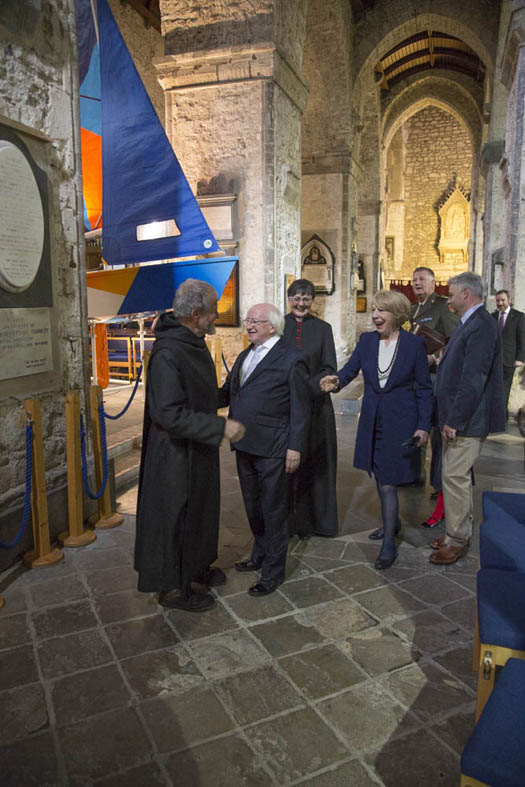
The President of Ireland is welcomed to the Naumachia in the Cathedral by Brother Anthony Keane of Glenstal Abbey. Also foreground are the Dean of Limerick the Very Reverend Sandra Bragnell, Mrs Sabina Higgins, and Gary MacMahon of Ilen Boatbuilding School.
It was the first time any new gandelows had been built in well over thirty years. This project was then further developed to build the CityOne Sailing Dinghies specifically for Limerick use, the unique design of these boats being drawn by naval architect Theo Rye to a detailed Limerick specification. With the new dinghies planned for completion at the height of Limerick's year as City of Culture, a CityOne International Graphic Arts Competition was also launched to create innovative ideas for the colour layouts on the sails and the hulls of the boats. It attracted 61 entries worldwide, and the four selected designs were from graphic artists in Kenya, Ireland Portugal and Texas.
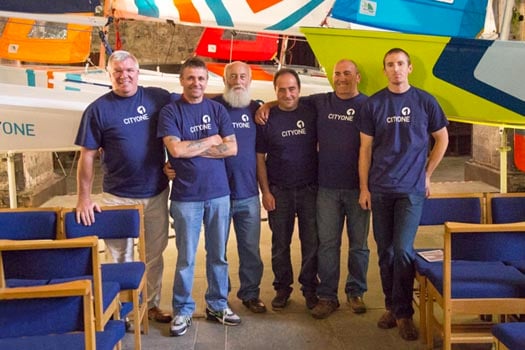
Participants in the Ilen School at the Cathedral included (left to right) Robert Smalle. Tony Broe, Liam O'Donoghue, James Madigan (Ilen School Instructor), Michael Grimes and Gary Wilmott.
It was the CityOne dinghies with their striking colour schemes which formed the centrepiece of the Naumachia in the Cathedral. But there were other exhibits linked to the many aspects of the Ilen School's work too, and in addition to meeting the boatbuilders and crews that sail the CityOnes, the President also met the "Gandelow Gang", who are drawn from the Limerick area both to make up the building teams for gandelows and CityOnes alike, and to row the gandelows in competition and traditional boat gatherings at home and abroad.
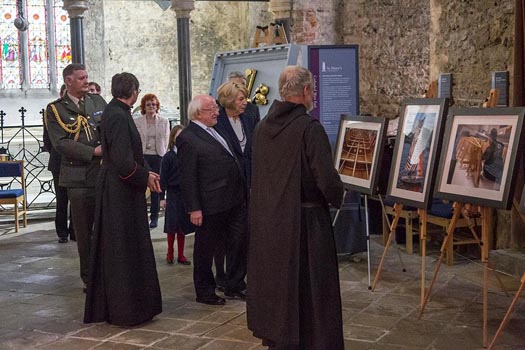
The Presidential party inspect the exhibits detailing the work of the Ilen School
In concluding his speech, the President summed up the mood of the day:
"I very much want to thank everyone involved in staging this exhibition here in this magnificent 12th Century building. What a great tribute it is to those who put all the original stones in place, that there is something new of the human spirit and craft being exhibited here. These boat builders, they are consummate craftsmen.
The international design dimension to the CityOne project is to be highly commended, and it is such a pleasure to be here with you today. I am delighted that the Ilen School project is part of the Limerick City of Culture. Isn't it wonderful that these skills are being passed down and developed, so that more and more people can take part, and for the community to see such inspiring craft?"
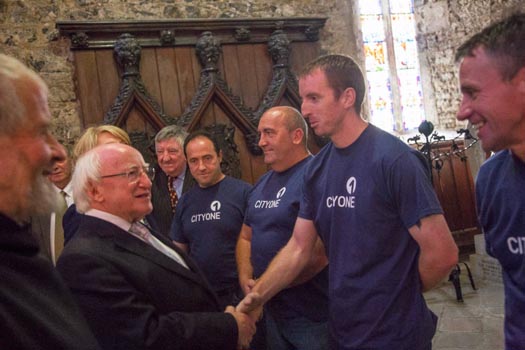
The President meets members of the Gandelow Gang and the Ilen Boatbuilding School including (left to right) James Madigan, Michael Grimes, Gary Wilmott and Tony Broe.
#scatteryisland Brian Ború's 10th century invasion of the monastic settlement of Scattery Island in County Clare and the subsequent killing of the Viking King of Limerick and his two sons will be recreated this weekend.
The Scattery Island Festival, which gets underway tomorrow morning and continues through Sunday, also features guided walks, lectures, music and song, and marine activities celebrating the island's association with St. Senan, the Vikings, Brian Ború, the Spanish Armada and later as a defence outpost for the British.
Uninhabited since 1979, Scattery Island - also known as Inish Cathaigh - is located approximately one mile from Kilrush in the Shannon Estuary and is home to a monastery founded in the early 6th century by St. Senan. The island features the ruins of six churches and one of the highest Round Towers in Ireland at 120 ft. high.
The re-enactment of the raid on the island by Brian Ború and his the Dál Cais army is the main event of the Scattery Island Festival, which is part of the national Brian Boru Programme and coincides with the millennial anniversary of Ború's death at the Battle of Clontarf in 1014.
Academics and historians have for many years argued whether or not Ború broke sanctuary by killing on church land as he sought revenge for the murder by King Ivar of his older brother and King of Munster, Mahon. Most agree however, that the incident consolidated Brian's position as Mahon's successor and helped him in his quest to become High King of Ireland.
Dr. Catherine Swift, Course Director, Irish Studies Mary Immaculate College explained: "The Annals of Inisfallen state that Ímar, king of the foreigners, and his two sons, were killed on Inis Cathaig by Brian, son of Cennétig in 977AD. In an account given in the Annals of Loch Cé meanwhile, Brian sees a vision of St Senán condemning him for breaking sanctuary by killing on church land which is taken to be this incident. Whatever one's opinion is of the manner in which the Norse King was slain, it is clear that his death paved the way for Brian to enjoy unchallenged rule over his home Province of Munster."
Rita McCarthy of the Scattery Island Heritage & Tourism Group said the re-enactment will be the focal point of this year's Festival, the theme of which is 'Invade Scattery'.
Also taking place during the course of the weekend will be a Ceremony of Remembrance for past inhabitants of the island, a Curragh Race, Music and Song with Inis Cathaigh Comhaltas, guided tours of the island by the OPW, talks on Scattery Island's environment and history, a Treasure Hunt for children, and tours to the Napoleonic Battery.
Ms. McCarhy continued: "We are inviting former island inhabitants and anyone with a connection with Scattery or indeed, its rich history to join us this weekend. Last year's inaugural festival, held as part of the Gathering Ireland initiative, proved to be a huge success with more than 5,000 people travelling to the island. This has helped to raise the profile of what has for many years been one of Ireland's least known monastic settlements."
The Scattery Island Festival is part-funded under the Community Tourism Diaspora Fund, operated locally by Clare County Council, IPB and Failte Ireland. For more visit www.brianborumillennium.ie, see Facebook (Scattery Island/Kilrush Gathering), or contact Rita McCarthy of the Scattery Island Heritage and Tourism Group on 087-9731162 / [email protected].
#cityone – The Ilen School CityOne Design Competition invites designers to submit designs for the sails and hull of a new CityOne performance sailing dinghy. Four of these CityOne dinghies are currently under construction through an innovative social educational programme in Limerick City.
As Afloat reported previously, The CityOne dinghy is a new performance dinghy, developed by the Ilen School and designed by naval architect Theo Rye as a legacy project of Limerick City of Culture 2014.
This exciting and challenging competition is open to all designers and high levels of creative freedom are encouraged for the task of designing a concept for application to the hull and sails.
Submissions must be sent by email to [email protected] There is no entry fee.
Three designs will be chosen by a judging panel and each single participant and group design chosen will receive €500* and enjoy the opportunity of seeing their designs creatively applied to the City One sail and hull before they take to the water for racing on the River Shannon, Limerick. The judging panel may also award additional non-monetary, special mentions.
Closing date for submissions Friday 25th July 2014. More on this on the City One competition page here.
#ScatteryIsland – Brian Ború's 10th century invasion of the monastic settlement of Scattery Island and the subsequent killing of the Viking King of Limerick and his two sons will be recreated in County Clare later this month.
The Scattery Island Festival on July 26th-27th also features guided walks, lectures, music and song, and marine activities celebrating the island's association with St. Senan, the Vikings, Brian Ború, the Spanish Armada and later as a defence outpost for the British.
Uninhabited since 1979, Scattery Island - also known as Inish Cathaigh - is located approximately one mile from Kilrush in the Shannon Estuary and is home to a monastery founded in the early 6th century by St. Senan. The island features the ruins of six churches and one of the highest Round Towers in Ireland at 120 ft. high.
The re-enactment of the raid on the island by Brian Ború and his the Dál Cais army is the main event of the upcoming Scattery Island Festival, which is part of the national Brian Boru Programme and coincides with the millennial anniversary of Ború's death at the Battle of Clontarf in 1014.
Academics and historians have for many years argued whether or not Ború broke sanctuary by killing on church land as he sought revenge for the murder by King Ivar of his older brother and King of Munster, Mahon. Most agree however, that the incident consolidated Brian's position as Mahon's successor and helped him in his quest to become High King of Ireland.
Dr. Catherine Swift, Course Director, Irish Studies Mary Immaculate College explained: "The Annals of Inisfallen state that Ímar, king of the foreigners, and his two sons, were killed on Inis Cathaig by Brian, son of Cennétig in 977AD. In an account given in the Annals of Loch Cé meanwhile, Brian sees a vision of St Senán condemning him for breaking sanctuary by killing on church land which is taken to be this incident. Whatever one's opinion is of the manner in which the Norse King was slain, it is clear that his death paved the way for Brian to enjoy unchallenged rule over his home Province of Munster."
Rita McCarthy of the Scattery Island Heritage & Tourism Group said the re-enactment will be the focal point of this year's Festival, the theme of which is 'Invade Scattery'.
Also taking place during the course of the weekend will be a Ceremony of Remembrance for past inhabitants of the island, a Curragh Race, Music and Song with Inis Cathaigh Comhaltas, guided tours of the island by the OPW, talks on Scattery Island's environment and history, a Treasure Hunt for children, and tours to the Napoleonic Battery.
Ms. McCarhy continued: "We are inviting former island inhabitants and anyone with a connection with Scattery or indeed, its rich history to join us on the weekend of July 26-27th. Last year's inaugural festival, held as part of the Gathering Ireland initiative, proved to be a huge success with more than 5,000 people travelling to the island. This has helped to raise the profile of what has for many years been one of Ireland's least known monastic settlements."
The Scattery Island Festival on July 26th-27th is part-funded under the Community Tourism Diaspora Fund, operated locally by Clare County Council, IPB and Failte Ireland. For more visit www.brianborumillennium.ie, see Facebook (Scattery Island/Kilrush Gathering), or contact Rita McCarthy of the Scattery Island Heritage and Tourism Group on 087-9731162 / [email protected].


























